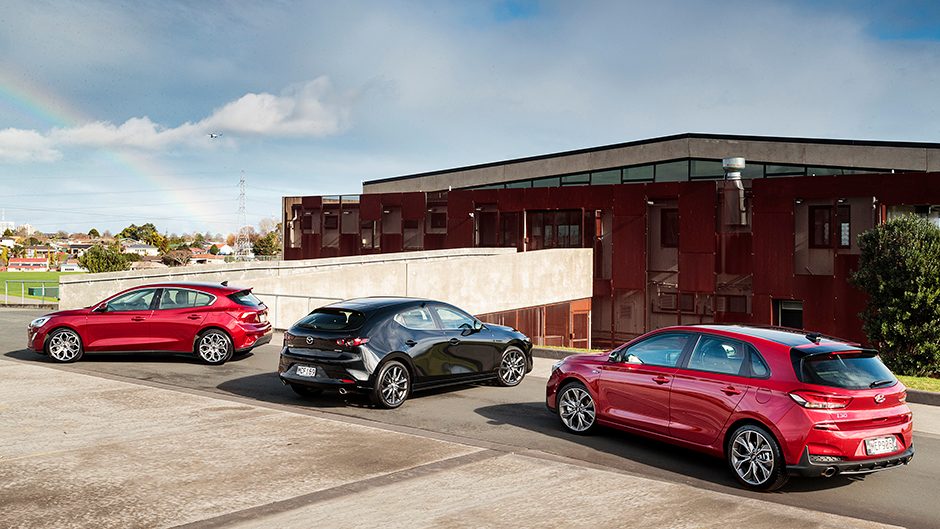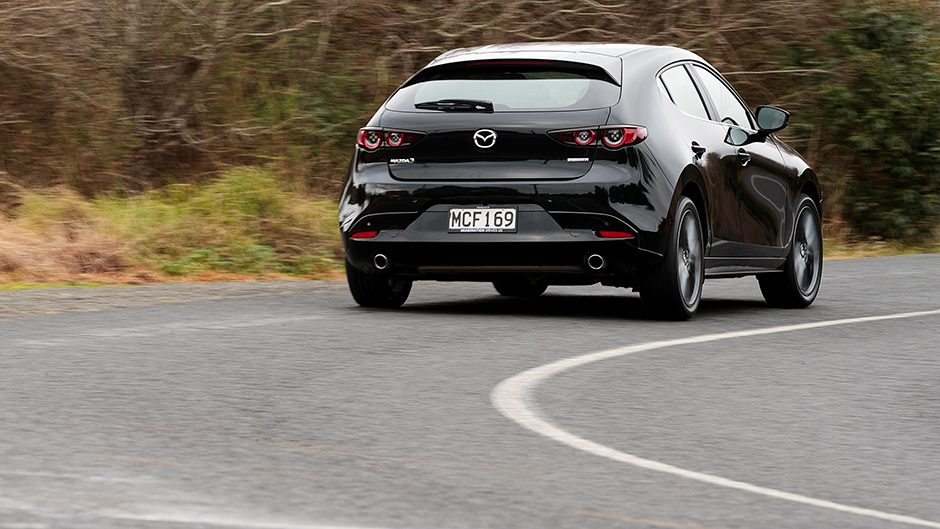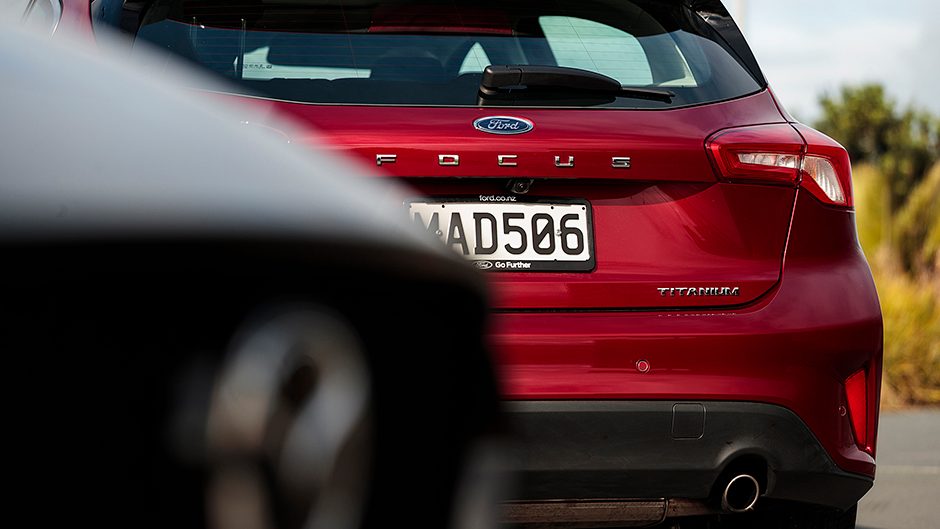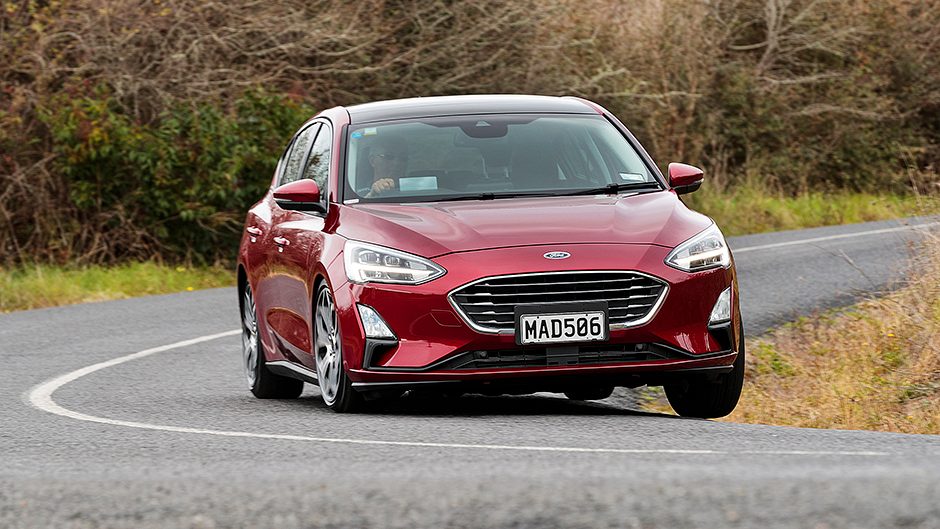With the feebate proposal raging, it’s a good time to ponder whether your car is fit for purpose. Do you need that ute for your commute (we know you’re in it for the FBT advantage) or that SUV for the school run? For town folk at least, the humble compact hatch should do nicely. It accommodates four comfortably, five at a pinch, and has reasonable boot space. Need more? Buy some roof racks and a box.
These hatchy things are good to drive, look snazzy and now come loaded with tech and features for $40k or less, with no options to tick. Just like these three here. Ford’s top-spec Focus Titanium adds the extras, while the new top i30 N-Line is a sports-luxury choice. Mazda has re-jigged its 3 range; there’s no longer a base stripper GLX, the entry point being the GSX. The new midgrade is the GT-X, a higher end offering with a price just above forty kay, while the Limited model now pushes the boat out past $48k. So all here ask similar money, but which should you opt for?

The city life
Ford’s Focus impressed those who drove it with its abundance of easy, everyday torque. The $41,990 Titanium uses a boosted 1.5-litre triple to deliver 134kW but it’s the 240Nm of surge readily delivered from a tick above idle that makes the Focus feel the stroppiest when rambling around town. The grunt spreads itself across the ‘everyday’ rev band, and this stream of torque is processed aptly by the Ford’s eight-speed auto. It sorts the gear swaps quickly, smoothly, so the Focus always feels right to go.
They used to say there’s no substitute for cubic inches, a route that Mazda has taken with its 3. Okay 2.5 litres ain’t big, but it is in a hatch nowadays. Mazda continues to hone its naturally aspirated engine technology, its latest 2.5 in the $40,975 GTX making 139kW with 252Nm tapped at 4000rpm. But even without a turbo to boost the torque curve, it feels like it ramps up early, with decent go from 2000rpm, and it revs sweetly. Mazda has stuck with a six-speed auto, which does a sound job. This too is quick with the changes, particularly when shuffling back down the ratios; give the gas pedal a wee prod and it doesn’t leave you hanging.
On paper, the 1.6-litre turbo in Hyundai’s $43,990 i30 N-Line should rule the roost. It makes 150kW with 265Nm on from 1500 to 4500rpm, but strangely it feels the least willing of the trio; it lacks the low down slug of the Focus, and feels less energetic than the Mazda’s 2.5. Its seven-speed twin-clutch auto isn’t as polished as the conventional autos here, especially at lower speeds, or when on an incline. It also likes to hook up into fifth and stay there, taking more persuasion to drop a cog, while it won’t always select the best gear for the task, particularly when intersections are involved.

The N-Line replaces the Limited in the local Hyundai line-up, a sports luxury version with a racy appearance kit which fooled a few into believing it to be the full N hot hatch. Sports suspension complements the look, springs tightened to hone the handling, but they also firm the ride. Michelin Pilot Sport 4s wrap the 18-inch rims, and these stick like mad in bends but also rumble on most NZ surfaces.
The Focus too has sporty rubber with Pilot Sport 3s employed, which also sound off, and the ride to work wasn’t as supple as that of the 3. Mazda has heaped the refinement on this new GTX, choosing Bridgestones with more flex in the sidewall to improve the ride. They’ve also muted road noise where possible. Even with the new torsion beam rear end, which is a similar set-up to that of the Focus, the 3 displays the best progress around town, although the Focus does diffuse speed bumps better.
We like Ford’s light and quick steering action, twirling between the stops with just 2.1 turns, even if there’s a hint of a self centring action to contend with. The N-Line’s steering feels artificially heavy in this company but the weighting is consistent and it has the best turning circle. While the Mazda has the slowest ratio, it has the best action, the assistance just so. All feature active cruise working right down to a halt in traffic. We found the Ford’s to be the smoothest, and handled traffic flows the best. The Mazda’s is good too, but too slow to get going again when the traffic ahead moves off. The Hyundai’s was jerkier in operation and more worried about cars in front, slowing right down when they pull over to turn, where the others will slip past them.

The 3’s side mirrors are on the small side, but all here have blind spot minders to help with lane changing. AEB features too, as do lane keeping systems, the Mazda’s potentially more intrusive than the others, though all are best switched off in town, and reactivated on main highways. The Mazda and Ford have speed sign recognition, and their speed readouts will glow red when you’re over the limit. Ford has a self parking function which gets the heart pumping, the system taking care of all manoeuvres, and getting pretty close to the other vehicles in the process. While Ford’s new rotary gear selector frees up space on the console, it doesn’t quite hook up smartly enough when changing between R and D.
The Focus has the best rear view camera though, with the largest, clearest image. As to fuel use, the Ford was reading 8.2L/100km, the Hyundai 8.4 with the Mazda on 8.8, though it didn’t accumulate as many motorway miles as the others during our test. You can expect them all to have a double digit average for short, round town trips while motorway cruising will net figures in the fives and low sixes.
Both Ford and Mazda’s stop-start systems work without being annoying, the Mazda’s quicker to refire, while Hyundai doesn’t bother with one. Ford and Mazda also employ cylinder deactivation, which makes the Mazda run a bit lumpy on the motorway, while you can only detect a slight change in the Focus’ engine note when it’s in action.

The vibe inside
Each is an okay looker, the Mazda stirring more debate with its ‘car as art’ styling. Some get it, others don’t. But on the other side of the metal, Mazda has raised the bar at this price point. Its interior feels crafted rather than manufactured, the surfaces more premium in appearance and feel. So are the buttons, particularly those on the slim spokes of the steering wheel, itself both elegant yet functional. The only bum note being some premature scuff marks on the piano black finishing of the centre console. The other two, though soft in the right places, have more hard bits on display.
The Hyundai exhibits a solid build quality but we prefer the design of the Focus; it’s got more of a modern vibe to it. Cloth trim doesn’t hurt Mazda’s premium aspirations as the seats themselves are the best here. They might be manually adjusted, but offer a good range of movement and, barring a lack of lumbar adjustment, they still give the best support and comfort with denser foams used. We thought the Mazda’s door handle felt flimsy at first, but place your elbow there while driving and you realise it’s intentional, forming a sumptuous rest spot for your arm. It’s these things that help elevate the Mazda’s ambience.
The leather accentuated Focus seat is flat, firm and formless but the seat heater is toasty while the hides on the i30 are rather hard. The Hyundai has a good range of adjustment and is a snugger fit than the Ford. The Mazda’s main dial is a TFT screen with a few view options and the HUD projects on to the windscreen proper, the Ford’s on a flip-up display atop the dash, while the Hyundai relies on conventional dials alone. Each has enough practical storage and useful cupholders, though only the Hyundai has a charge pad.
Mazda’s infotainment is now controlled solely via the twisty knob on the console, but they’ve honed its operation, being quicker and slightly more intuitive. Entering sat nav destinations can be time consuming however. The others use a touchscreen, the Hyundai not too vexing to operate though Ford’s Sync system is better, with easy voice control and a bigger, hi-res screen. All have smartphone connect and you can expect smart keys, parking sensors and cameras and dual zone air in each.
The N-Line adds sporty inspiration in the i30 cabin with red-stitched leather seats, which are both ventilated and heated. And there are racy red seat belts, something Porsche would charge $800 a pair for. It’s a very black affair inside the Mazda3, and the shrinking glass house and chunky C pillar won’t endear it to claustrophobics. The others feel much lighter and airier inside, particularly the Focus with a light grey headliner and glass roof. And it’s the Ford that leads on interior space when it comes to squishing three across with the most leg and head room.
The opening for Mazda’s rear doors is a bit mean, and there’s not as much head room as in the others either. In the boot they are all about even for width and length under the cargo cover, but the Mazda lacks depth and its rakish tailgate eats into its maximum load carrying ability.
Pushing it along
As Louisson mentions in his piece on the sedan, the Mazda3 does flow along sweetly. It’s imbued with a touch of MX-5 this, compliant yet in control, you just need to caress it around the bends and it follows your instruction faithfully. The steering is about perfect for a hatch, turning naturally and giving back when needed. It does a better job of filtering kickback than the others too.
You wouldn’t pick this 3 has changed to a torsion beam rear, for it doesn’t wander around over the bumps and so there’s no steering corruption as a result. It rides well at speed too, and quietly. There’s now torque vectoring via brakes, which activates only when really necessary. The Sport mode works well enough that you don’t bother with the manual lever either. There’s good go in the 2000-4000rpm zone for cruising, and the 2.5 will spin to 6000rpm when working it over.
The i30 holds a line well through a bend, the Michelin rubber really biting, but also roaring. There’s more tension in the suspension here, and while it limits movements, it also transfers more energy from the bumps. The steering is a mite quicker than the Mazda’s, but is seriously hefty in the Sport mode, while it’s more prone to kicking back in rough corners. The 1.6’s extra puff is more evident at higher revs, and the twin clutch keeps the engine churning above 3000 for best response. It’s not the slickest example in the business however, the occasional paddling needed but the brakes are up to the task when tested. The i30’s chassis is fairly decent but can’t match the Focus and Mazda3 for finesse.
There’s little that separates the 3 and Focus in the bends, the Focus with faster steering that sees it dive into turns eagerly. This Ford transitions sweetly through a series of curves, the chassis balanced and nimble. The Focus is a touch sportier, more pointy, but it’s a jot more fidgety over a series of bumps, and there are more road and suspension noises. We detected a few cabin squeaks on the go too. The grunt from the 1.5 is decent when you stretch it and it’s helped by a quick-witted auto, which needs no paddling, at least in Sport mode.
So what’s it to be?
The i30 N-Line is the second runner-up here, not doing enough to justify its higher price, while the chassis and powertrain are outpointed too. It’s a good looker, loaded and well built however. We found it hard to separate the Mazda and Focus from a driver’s viewpoint, but the 3’s added on-road refinement and interior ambience sway it for us, along with its big five-year warranty and service package.
If you’re after more interior space, or that Mazda look isn’t for you, the Focus will do you well, especially if you prefer them a bit sporty. In that regard, we’d recommend the ST-Line over the Titanium, which is cheaper still.
| Model | Ford Focus Titanium | Price | $41,990 |
| Engine | 1496cc, IL3, T/DI, 134kW/240Nm | Drivetrain | 8-speed auto, front-wheel drive |
| Fuel Use | 6.0L/100km | C02 Output | 135g/km |
| 0-100km/h | 8.90sec | Weight | 1392kg |
| Model | Hyundai i30 N-Line | Price | $43,990 |
| Engine | 1591cc, IL4, T/DI, 150kW/265Nm | Drivetrain | 7-speed twin-clutch, front-wheel drive |
| Fuel Use | 7.5L/100km | C02 Output | 173g/km |
| 0-100km/h | 6.84sec | Weight | 1420kg |
| Model | Mazda3 GTX | Price | $40,795 |
| Engine | 2488cc, IL4, DI, 139kW/252Nm | Drivetrain | 6-speed auto, front-wheel drive |
| Fuel Use | 6.6L/100km | C02 Output | 154g/km |
| 0-100km/h | 7.75sec | Weight | 1394kg |


